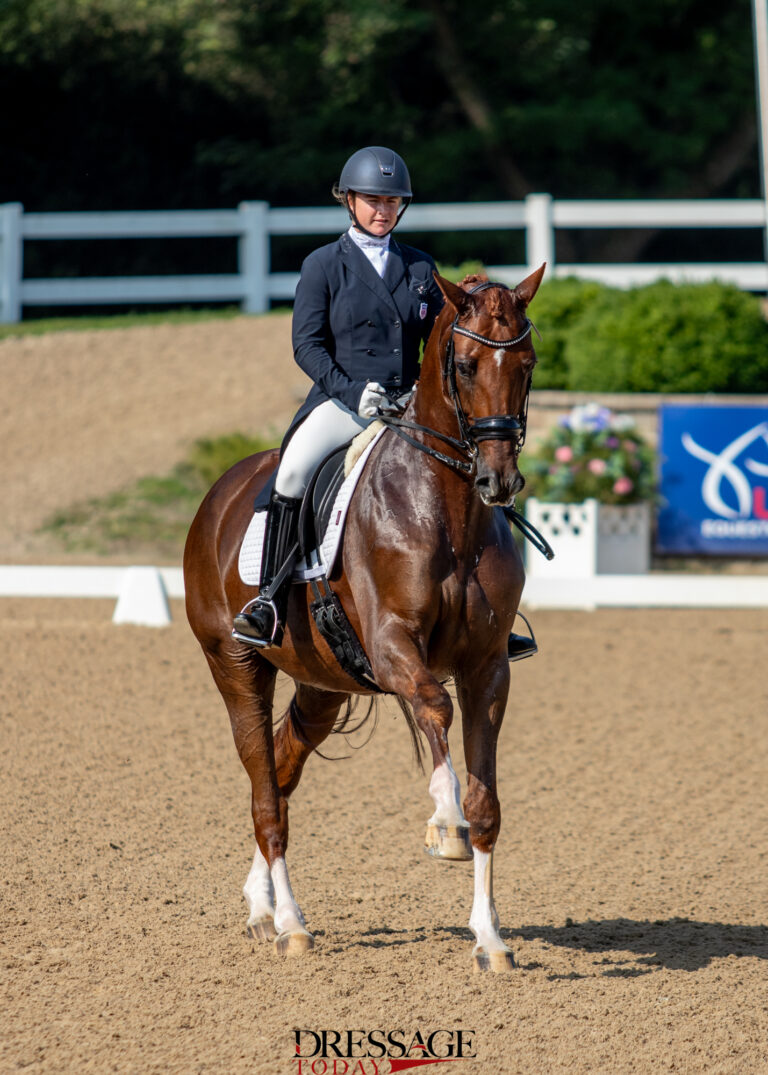It was a cool morning at Fieldstone Farm Therapeutic Riding Center in Ohio, the site of the Professional Association for Therapeutic Horsemanship International (PATH Intl.) Horse Exposition. Hundreds of conference attendees gathered in the large indoor arena, watching a demonstration by Canadian Paralympic Dressage medalist and Parelli 4-Star Instructor Lauren Barwick.
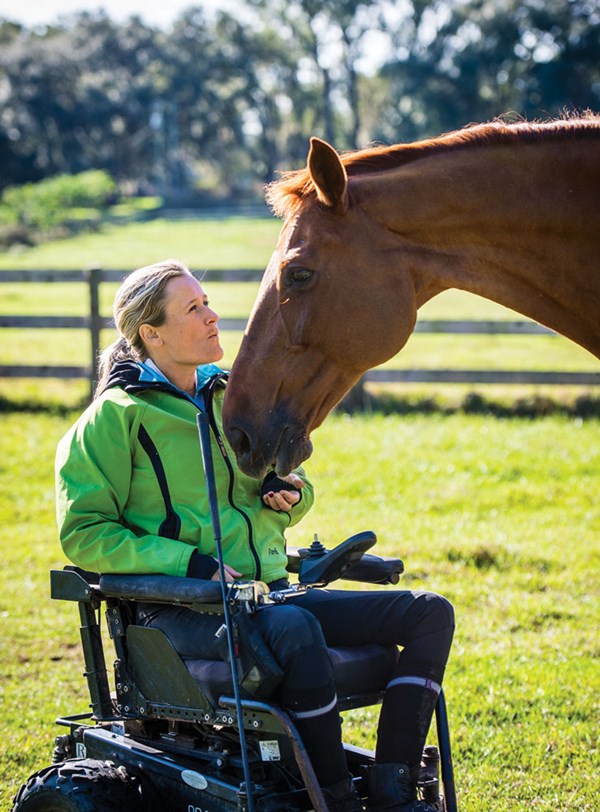
Barwick, seated in an all-terrain wheelchair, introduces her warmblood mare, Peanut, who is wearing a rope halter and line. Operating her wheelchair with one hand while holding Peanut’s line in the other, Barwick leads Peanut around the arena and then circles the mare on the line at a walk, trot and canter. After Peanut has moved in both directions, Barwick cues her to come to the center of the circle, where Peanut lowers her head, allowing Barwick to easily remove the rope halter. With focused intention and subtle cues from voice, body and training stick, Barwick invites Peanut to engage in all the same groundwork exercises, only now at liberty. Peanut tunes in to Barwick’s nearly imperceptible cues, horse and handler a living picture of lightness and precision.
Finding Her New Normal
Barwick has competed in dressage in the 2004, 2008 and 2012 Paralympic Games, earning gold and silver medals in Hong Kong (2008) as well as bronze and silver medals at the 2014 World Equestrian Games in Normandy, France. Currently training from her facility in Reddick, Florida, Barwick continues to compete internationally on behalf of her native Canada and was named Canada’s 2014 Equestrian of the Year. In 2015, she was inducted into Canada’s Paralympic Hall of Fame. Barwick’s life mission? She is passionate about helping people and horses move past personal roadblocks.
“I was born into a family of three kids,” says Barwick. “My brother suffered a severe brain injury as a child, and my sister was born with Down syndrome. I spent my life trying to accomplish a lot—striving to do for my siblings what they could not. Then, in 2000, at the age of 22, I broke my back when a 100-pound hay bale fell from 10 feet onto my spine. From that point forward, I’ve had no feeling or movement from my waist down.”
Before her injury, Barwick had competed in eventing and show jumping. She therefore had some background with dressage, though it was her least favorite and successful element of eventing due to a self-proclaimed “lack of patience.” When she left the hospital after her injury and initial recovery, Barwick had decided she would never ride a horse again. It seemed impossible that riding with her newly imposed physical limitations could ever be meaningful or rewarding.
However, back home Barwick ventured out to the pasture to visit her horses. Peanut, who had always been a difficult and resistant horse to train, approached her. Peanut had never see a wheelchair before, but the mare immediately lowered her head, allowing Barwick to touch her, groom her and even halter and lead her down the driveway. In part because of this connection with Peanut, whom Barwick now calls her “heart horse,” she reconsidered and decided to try riding again, an experience that was terrible at first. “When I got on the first time, it was the worst feeling ever because I had zero sensation of being on a horse or of the horse moving beneath me. Riding was something I had done my entire life. I had to spend hours just getting this new feeling—of feeling nothing—to be my new normal.”
Barwick rode in a Western saddle on a quiet, older horse with a horse leader and two side-walkers. Crying and angry about the circumstance and frustrated by the terrible lack of sensation, she realized, “The choice was mine. I could spend my whole life asking ‘Why me?’ and turning away from all I wanted to do. Or I could acknowledge that I still wanted to be an athlete. I could start asking ‘Why not me?’ and embrace this new normal and the opportunities for riding and competing that went with it. If I really wanted to fulfill my potential as a rider and as a human being I had to turn this around.”
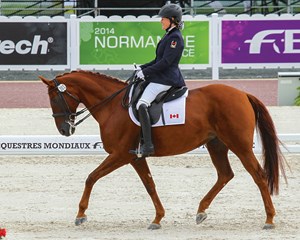
With a shift in attitude and many hours in the saddle, Barwick was able to accomplish a lot, and quickly. Within a month of her first ride post-injury she had walked, trotted and cantered. Members of Canada’s Para-Equestrian community took notice and encouraged her to consider training for Para-Equestrian Dressage competitions. Barwick’s competitive riding background, commitment to personal fitness, intuitive connection with horses and intense personal drive all made her a natural fit. This new goal required her to transition to riding in a less-supportive English saddle, which, she says, was, “again, terrible. I couldn’t go from a walk to a halt without falling forward onto the horse’s head.” At this point, Sandra Diamond and Sandra Verda, who coached her through hours of riding, trying different horses and preparing for shows, encouraged Barwick.
In 2002, just two years post-injury, Barwick began competing internationally, representing Canada at the Open European Championships in Portugal. Of this experience she says, “Portugal was eye-opening. I got to see riders with extreme disabilities competing in Para-Equestrian Dressage and they were riding better than I could before I was injured. These were riders with disabilities who rode regularly in able-bodied competitions through Grand Prix, and also competed in Para to get to the world level. I saw that dressage was a sport where I could excel. I also realized that I didn’t want to be led around and/or have my horses trained solely by someone else. I wanted to be an integral part of my horses’ lives and involved with even their basic training. That way, when I would sit on the awards podium, I would be there because my horse and I had done it together.”
The Use of Natural Horsemanship
In hopes of training her own horses despite the significant extra challenges associated with doing so with paraplegia, Barwick turned to renowned Natural Horsemanship trainers Pat and Linda Parelli. She traveled to Colorado, where Pat Parelli gave her the opportunity to ride one of his own horses over extreme mountain terrain, an experience Barwick describes as “scary and exhilarating! But the horse had an amazing foundation and took care of me.” She became convinced it was essential for her international-competition horses to have this same foundation, in part so they would respect and take care of her as they travelled the world. “My life is incredible because of what horses and the sport of dressage can give me,” says Barwick. The groundwork training and Parelli freestyle riding I do with my horses keeps them happier and more engaged so they can be more successful.”

Barwick’s fundamental relationship with her horses and systematic approach to training help her know her horses well and therefore more accurately assess risk. “I am a risk-taker. But there has to be a safety level. I’ve learned that becoming a detail person when training makes me safer. As riders, we need to not just take a risk, but rather to look at both sides of it, weigh it out, understand what we’re getting into and be OK with what the consequences could be. When I go into a situation with a horse, I either say: ‘I’ve bought into this and I’m doing it’ and am fully committed or I just won’t do it. That way, I can hold myself accountable to the decision. At the end of the day, when you’re successful you can then also say, ‘Wow, I did that, too.’” Barwick credits this honed ability to accurately assess risk as part of what enables and empowers her to train horses so successfully.
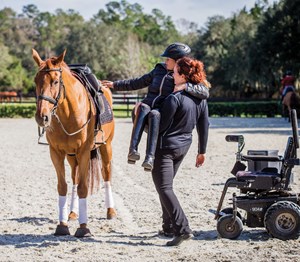
Barwick’s background as a Parelli professional has influenced her core beliefs about training, including for dressage. “Each horse learns differently, just like each human,” she says. “The best trainer is able to tailor the way they train to each individual. The decision about what works for each horse—whether to use treats, pressure, praise, cross-training, higher intensity or lower intensity work—that’s what makes a good trainer, rider and coach. Another belief I have is to practice whatever you’re working on correctly but for a shorter period of time. As the saying goes, ‘Perfect practice makes perfect!’ Pepper it in! Most horses do better that way.”

Barwick’s strong understanding of rider biomechanics and commitment to personal fitness also play a major role in her success. “Dressage riding involves never-ending challenge and self-improvement. It’s really quite difficult! I get to the gym four times a week and train on aerobics machines alongside my fiancé. I will wheel up to 10 kilometers on the road, working on shoulder strength as my shoulders do everything for me. At times, I’ll ride four to six horses a day, always thinking about developing core strength, which is most important. I don’t ever want to ride with my hands, so I have to have a strong core and resulting good seat. Like any good dressage rider, seat is everything and I can affect my seat through my core.”
Influencing the Dressage World
Barwick’s advice for aspiring Para-Equestrian Dressage riders? “Most important, be open and honest with instructors. Tell them the dressage has got to be pure. Tell them it will be an interesting challenge to teach someone who cannot use the same aids that they use how to get the horse to go correctly.” She emphasizes that in Para-Equestrian dressage there is nothing compromised about the dressage. She explains that many confuse Paralympics with Special Olympics or therapeutic riding programs that may have very different goals from ultra-competitive Paralympics. “In Para-Equestrian competition, the dressage has to be 100 percent correct. I’d advise dressage riders with disabilities, who may be less able to influence the horse’s gaits, to look for competition horses with very pure, quality gaits. And find a trainer who is willing not just to think outside the box, but who will look at you and your training and ask, ‘What box?’”
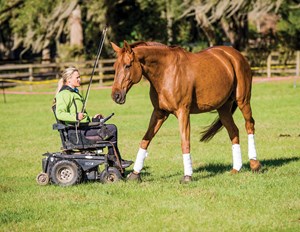
Barwick is an athletic, talented, young trainer who has big goals and even bigger ideals about how she would like to influence the dressage world. “A dream of mine is to compete Grand Prix as a paralyzed rider, but I am going to need a special horse for that. From 2002 to 2005, Andrea Taylor leased me a wonderful Grand Prix horse. Back then, I was still learning to ride all over again. I wish I had this horse now that I’m the rider I am today. I know I could compete Grand Prix, as I’ve already ridden the individual movements, and I dream of having the horse who would help me put it all together. And I do own a property in Florida where I train and give clinics. I’d like nothing more than to have a program here, specifically for developing Para-Equestrian dressage riders. The Ocala area is just such an ideal place to grow as a Para-Equestrian—you can compete every weekend in dressage and really gain experience and exposure. I also have my own retired competition horses here who know their job and are good for others to learn on.” She pauses for a moment before adding, “And after Rio, I want to have a baby!”
Barwick hopes the able-bodied dressage world will gain a better understanding of Para-Equestrian dressage and will discover the talent and abilities Para-Equestrians have. Sometimes being challenged to overcome or compensate for a disability while riding and training is actually a gift: one that allows the Para-Equestrian to bring new and inspired insights to how to best motivate a horse to perform or to maximize the abilities and strengths that a particular athlete, human or equine, has to offer.

“Quite often we [Para-Equestrians] are just dismissed as disabled people who are out riding for a feel-good moment,” Barwick says. She pauses for a moment before adding, “In contrast, I’m out riding because it is my job. When I compete in able-bodied dressage shows, I’m coming out to win your class. I’m riding to say: Here I am!”
The Paralympics
The International Paralympic Committee (IPC) describes the Paralympics as “Olympic-style games for athletes with impairments.” The IPC emphasizes that the “Para” in Paralympics indicates games that are held “parallel”—and equal—to the Olympic Games. Since 1998, Paralympic Games have taken place during the same year and in the same venue as the Olympics, to include athletes with impairments in a world-class competitive setting. Dressage is currently the only equestrian sport represented in Paralympic Games and has been governed by the FEI since 1996.
Adaptations for Harmonious Dressage
At the 2015 Professional Association for Therapeutic Horsemanship International Horse Exposition at Fieldstone Farm in Ohio, Lauren Barwick’s mare, Fergi, is clearly energized by the cold, the audience and the unfamiliar arena, yet her attention remains on Barwick. After groundwork, Barwick cues Fergi to come to the center of the circle. She drops the rope, ground-tying the large bay mare who stands quietly. Barwick elevates the seat of her wheelchair; then, without assistance, she lifts a dressage saddle over her head and onto Fergi’s back, proceeding to tack the mare completely. Next, two friends assist Barwick from her wheelchair onto Fergi’s back. She settles into her customized saddle, which features large standard knee rolls, extra blocks behind her thighs and a mounted handle bar. She applies Velcro straps, designed to break loose in an emergency, over her thighs while her assistants do the same with straps around boots and stirrups. The straps help Barwick maintain the position of her lower extremities, over which she has no visceral control. An assistant then hands Barwick two dressage whips, one for each hand, which she uses to cue Fergi in place of typical leg aids.

At Barwick’s cue, Fergi marches forward with an energetic, swinging free walk. An assistant turns on pop music with inspirational lyrics (think Sara Bareilles’s “Brave”). Barwick and Fergi school at walk, trot and canter, including collection and extension at all gaits, lateral movements and flying changes of lead. The accuracy, precision and fluidity with which the pair execute advanced movements highlight Barwick’s exceptional athleticism and showcase Fergi’s dynamic warmblood gaits. They are clearly an intently focused world-class competitive team. At the same time, Barwick’s playful approach, frequent praise for her horse and choice of music also give the impression of a deeply intuitive rider out having fantastic fun with her highly engaged horse. Among the audience, there is the undeniable feeling of reverence, captivation and elevation that watching the very best dressage inspires. We bear witness to a level of harmony between horse and rider where each is empowered by the other to become greater than she would be alone.
Preparing for Rio
Preparation for the 2016 Olympic Games takes place inside and outside of the dressage arena. In June, Lauren Barwick attended a three-day Paralympic Orientation in Canada, where she and her prospective teammates were informed about logistical requirements. Barwick explains, “As we’re now three months out from Rio, I am really shifting my focus away from teaching to be able to train myself and Onyx more intensely.”
Barwick acquired Onyx, whom she is riding on the cover of this month’s issue, in October 2015, and the pair has already participated in nine national/international competitions, consistently scoring between 72 and 84 percent. “Between now and Rio, the focus will be on fine-tuning our freestyle,” she says. “We will work to get our footfalls more precisely timed with the music, really perfecting our tempos and rhythm throughout.”
At her training facility in Reddick, Florida, Barwick and Onyx have had visits from members of the Canadian Para-Equestrian management team, including coach, physical therapist and veterinarian, all to ensure that they are prepared physically, mentally and emotionally. Onyx has been having body work done regularly so that Barwick and her team will know exactly what he responds to and be able to best support his performance in Rio.
“In the remaining months, I’m careful not to introduce too much that’s new,” says Barwick. “Instead, I make sure to focus on consistent training. But I also recognize that improvement takes time and sometimes you have to accept small imperfections for the good of the overall performance and development of the horse.
“For me, competing at the Paralympic Games brings with it the feeling that all our hard work has paid off,” continues Barwick. “It represents competing at the highest level you’re capable of and having earned the right to be there. I’m excited to wear that maple leaf, to compete alongside my teammates. As always, it’s exciting and most important to be a partner to my horse in the arena.”





